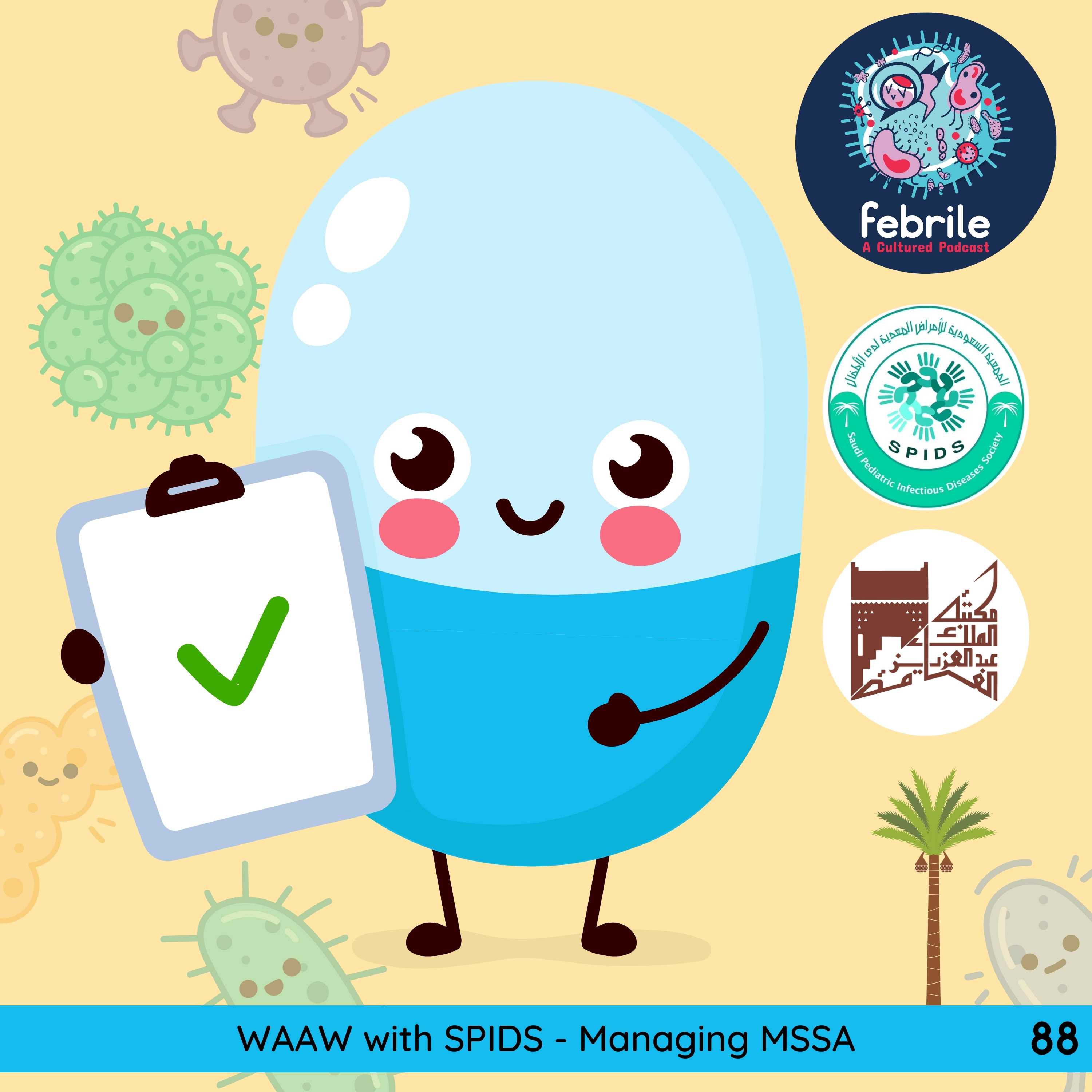Table of Contents
Credits
Host: Sara Dong
Guests: Rabab Alghaithi, Meshari Alabdullatif
Writing/Producing/Editing/Cover Art: Sara Dong
Our Guests

Dr. Rabab Alghaithi
Dr. Rabab Alghaithi is a Pediatric Infectious Disease Consultant at King Fahad Medical City, Riyadh. She completed a fellowship in pediatric and adult Infectious Disease at University of British Columbia, Vancouver, Canada and a Pediatric Infectious Disease Diploma from Oxford University, Oxford, UK.
Dr. Meshari Alabdullatif
Dr. Meshari Alabdullatif is the Medical Affairs Manager for BD in Saudi region. Meshari develops and leads cross-over collaborations to address Saudi unmet health needs. He is a certified microbiology consultant and holds Ph.D. in Microbiology and Immunology from University of Ottawa in Canada
Culture
Rabab likes baking and cooking as well as exercising and being active! She used to crochet as well and is hoping to pick that back up. She also loves to spend time with family and friends
Meshari likes sports, particularly playing soccer, and spending time with family and friends. He likes camping and finding ways to have peaceful isolation as well
Consult Notes
Consult Q
Please assist in management of persistent MSSA infection
Key Points
Welcome to a three episode series recorded live at the World Antimicrobial Resistance Awareness Week (WAAW) Forum held and organized by the Saudi Pediatric Infectious Diseases Society (SPIDS) in collaboration with Febrile and the King Abdulaziz Public Library
In addition to our guests that you’ll meet on episodes 86-88, a special thank you to:
- Dr. Rana Almaghrabi, President of SPIDS
- Dr. Fatimah Aldubisi, Head of Scientific and Research Committee
Key Resources
- Tamma PD, Aitken SL, Bonomo RA, Mathers AJ, van Duin D, Clancy CJ. Infectious Diseases Society of America Antimicrobial-Resistant Treatment Guidance: Gram-Negative Bacterial Infections. Infectious Diseases Society of America 2023; Version 3.0. Available at https://www.idsociety.org/practice-guideline/amr-guidance/.
- McMullan BJ, Campbell AJ, Blyth CC, et al. Clinical Management of Staphylococcus aureus Bacteremia in Neonates, Children, and Adolescents. Pediatrics. 2020;146(3):e20200134. doi:10.1542/peds.2020-0134
- Shane AL, Hansen NI, Stoll BJ, et al. Methicillin-resistant and susceptible Staphylococcus aureus bacteremia and meningitis in preterm infants. Pediatrics. 2012;129(4):e914-e922. doi:10.1542/peds.2011-0966
The patient example case was persistent MSSA bacteremia in a neonate
- Optimal management of MSSA bacteremia in neonates (and really any other child) is removal of invasive devices such as lines, source control, and early initiation of anti-staphylococcal beta-lactam agent (oxacillin or nafcillin) or cefazolin
- We discussed selecting between anti-staphylococcal penicillins (oxacillin/nafcillin) vs cefazolin
- Some general references for S.aureus in the NICU/hospitalized infants:
- Carey AJ, Long SS. Staphylococcus aureus: a continuously evolving and formidable pathogen in the neonatal intensive care unit. Clin Perinatol. 2010;37(3):535-546. doi:10.1016/j.clp.2010.05.002
- Ericson JE, Popoola VO, Smith PB, et al. Burden of Invasive Staphylococcus aureus Infections in Hospitalized Infants. JAMA Pediatr. 2015;169(12):1105-1111. doi:10.1001/jamapediatrics.2015.2380
- Achermann Y, Seidl K, Kuster SP, et al. Epidemiology of Methicillin-Susceptible Staphylococcus aureus in a Neonatology Ward. Infect Control Hosp Epidemiol. 2015;36(11):1305-1312. doi:10.1017/ice.2015.184
What is the inoculum effect?
- MSSA isolates have been noted to exhibit elevations in first generation cephalosporin MICs when a greater than standard inoculum was used in susceptibility testing → this phenomenon was referred to as the inoculum effect (which affects 1GCs including cefazolin and cephalexin but not nafcillin/oxacillin)
- Quinn EL, Pohlod D, Madhavan T, Burch K, Fisher E, Cox F. Clinical experiences with cefazolin and other cephalosporins in bacterial endocarditis. J Infect Dis. 1973;128:S386-S389. doi:10.1093/infdis/128.supplement_2.s386
- Chapman SW, Steigbigel RT. Staphylococcal beta-lactamase and efficacy of beta-lactam antibiotics: in vitro and in vivo evaluation. J Infect Dis. 1983;147(6):1078-1089. doi:10.1093/infdis/147.6.1078
- Inoculum effect led to a concern for utilizing cefazolin for high inoculum or deep-seated infections, such as osteomyelitis → although there has been controversy on the clinical impact of inoculum effect and how this should influence therapeutic decision making
- There are some studies that suggest inoculum effect reduces the activity of cefazolin
- Miller WR, Seas C, Carvajal LP, et al. The Cefazolin Inoculum Effect Is Associated With Increased Mortality in Methicillin-Susceptible Staphylococcus aureus Bacteremia. Open Forum Infect Dis. 2018;5(6):ofy123. Published 2018 May 23. doi:10.1093/ofid/ofy123
- Nannini EC, Singh KV, Arias CA, Murray BE. In Vivo Effects of Cefazolin, Daptomycin, and Nafcillin in Experimental Endocarditis with a Methicillin-Susceptible Staphylococcus aureus Strain Showing an Inoculum Effect against Cefazolin. Antimicrob Agents Chemother. 2013;57(9):4276-4281. doi:10.1128/AAC.00856-13
- But observational clinical studies haven’t clearly illustrated an increased risk of treatment failure or mortality
- Chong YP, Park SJ, Kim ES, et al. Prevalence of blaZ gene types and the cefazolin inoculum effect among methicillin-susceptible Staphylococcus aureus blood isolates and their association with multilocus sequence types and clinical outcome. Eur J Clin Microbiol Infect Dis. 2015;34(2):349-355. doi:10.1007/s10096-014-2241-5
- Song KH, Jung SI, Lee S, et al. Characteristics of cefazolin inoculum effect-positive methicillin-susceptible staphylococcus aureus infection in a multicentre bacteraemia cohort. Eur J Clin Microbiol Infect Dis. 2017;36(2):285-294. doi:10.1007/s10096-016-2799-1
- There is limited data on the prevalence or clinical significance of inoculum effect in the pediatric population
- This study of the epidemiology and impact among pediatric osteoarticular infections noted an association between infection caused by CzIE strains and progression to chronic osteomyelitis: McNeil JC, Sommer LM, Boyle M, et al. Cefazolin Inoculum Effect and Methicillin-Susceptible Staphylococcus aureus Osteoarticular Infections in Children. Antimicrob Agents Chemother. 2020;64(9):e00703-20. Published 2020 Aug 20. doi:10.1128/AAC.00703-20
We discussed some of the combo regimens that might be used for persistent MSSA bacteremia. Use of an adjunctive agent is an option, although data is limited:
- Oxacillin + Gentamicin or Oxacillin + Rifampin
- Grillo S, Puig-Asensio M, Schweizer ML, et al. The Effectiveness of Combination Therapy for Treating Methicillin-Susceptible Staphylococcus aureus Bacteremia: A Systematic Literature Review and a Meta-Analysis. Microorganisms. 2022;10(5):848. Published 2022 Apr 20. doi:10.3390/microorganisms10050848
- Tan TQ, Mason EO Jr, Ou CN, Kaplan SL. Use of intravenous rifampin in neonates with persistent staphylococcal bacteremia. Antimicrob Agents Chemother. 1993;37(11):2401-2406. doi:10.1128/AAC.37.11.2401
- Cefazolin + Ertapenem is an interesting salvage regimen we discussed in more detail during the episode
- Ertapenem in combination with anti-Staph beta-lactams has been described as potential salvage therapy in adults
- There is of course some concern for necessity of a broad-spectrum carbapenem agent and downstream effects on the microbiome and resistance
- Meropenem has been studied as empiric therapy in preterm neonates with LOS compared to standard therapy (ampicillin/gentamicin or cefotaxime/gentamicin)
- Authors found evidence meropenem improved safety, mortality
- Also demonstrated that it didn’t increase risk of meropenem-R GN organisms
- Lutsar I, Chazallon C, Trafojer U, et al. Meropenem vs standard of care for treatment of neonatal late onset sepsis (NeoMero1): A randomised controlled trial. PLoS One. 2020;15(3):e0229380. Published 2020 Mar 4. doi:10.1371/journal.pone.0229380
- Data to guide ertapenem dosing in preterm neonates is lacking
- So often relying on case reports for designing appropriate treatment regimens
- There is actually more pharmacokinetic data with oxacillin in preterm neonates, particularly when used for invasive infections
- Resources:
- Ulloa ER, Singh KV, Geriak M, et al. Cefazolin and Ertapenem Salvage Therapy Rapidly Clears Persistent Methicillin-Susceptible Staphylococcus aureus Bacteremia. Clin Infect Dis. 2020;71(6):1413-1418. doi:10.1093/cid/ciz995
- Sakoulas G, Olson J, Yim J, et al. Cefazolin and Ertapenem, a Synergistic Combination Used To Clear Persistent Staphylococcus aureus Bacteremia. Antimicrob Agents Chemother. 2016;60(11):6609-6618. Published 2016 Oct 21. doi:10.1128/AAC.01192-16
- El-Dalati S, Sridaran S, Uricchio M, Kline EG, Shields R. Oxacillin plus ertapenem combination therapy leads to rapid blood culture clearance and positive outcomes among patients with persistent MSSA bacteraemia: a case series. JAC Antimicrob Resist. 2021;3(3):dlab148. Published 2021 Sep 29. doi:10.1093/jacamr/dlab148
- Akers SM, Kinney K, Butcher MI, Moïse A. Clearance of Persistent Staphylococcus aureus Bacteremia in a Preterm Neonate With the Use of Combination Cefazolin and Ertapenem. J Pediatr Pharmacol Ther. 2020;25(6):547-551. doi:10.5863/1551-6776-25.6.547
- Hitchins M, O’Mara K, Edwards L, Bouchard J. Treatment of persistent methicillin-susceptible Staphylococcus aureus bacteremia and presumed osteomyelitis with oxacillin and ertapenem in a premature neonate. Pharmacotherapy. 2023;43(1):96-99. doi:10.1002/phar.2745
- We also discussed why this regimen might work. Here are some studies trying to investigate that:
- One study suggested cefazolin + ertapenem in vitro stimulates IL-1b release from peripheral blood monocytes both with and without SA presence
- Ertapenem may reduce cefazolin concentrations required to eradicate MSSA biofilms
A few miscellaneous resources:
- Some CDC definitions were mentioned on the episode related to central line associated bloodstream infections.
- Here is a slidedeck related to CLABSI from the CDC: https://www.cdc.gov/infectioncontrol/pdf/strive/CLABSI101-508.pdf
- You can also check out this prior Febrile episode #60 on CLABSIs
- A resource on biofilm:
Infographics
Goal
Listeners will be able to understand the possible management options for treating persistent MSSA infection
Learning Objectives
After listening to this episode, listeners will be able to:
- Describe a bacterial biofilm
- Discuss the term “inoculum effect” as it relates to MSSA
- Identify some of the combination therapy options that have been used to address persistent MSSA bacteremia
Disclosures
Our guests as well as Febrile podcast and hosts report no relevant financial disclosures
Citation
Alghaithi, R., Alabdullatif, M., Dong, S. “#88: WAAW with SPIDS – Managing MSSA”. Febrile: A Cultured Podcast. https://player.captivate.fm/episode/ea05e7c6-2ec1-4fff-85ac-49e44ef87b74


